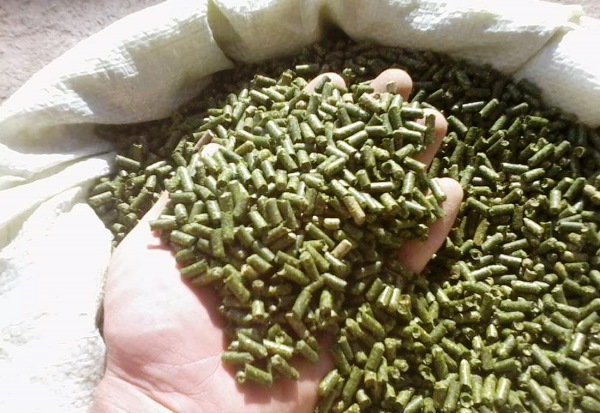Due to the content of rabbits in cages or cages, they cannot independently feed themselves, and this task relies entirely on the owner.
Therefore, it is necessary to make a diet so that the animal receives all the necessary vitamins and minerals. Proper feeding is the key to the health and rapid growth of rabbits. Therefore, in this article we will talk about feed for rabbits, its composition and cooking at home.
Table of contents
Good compound feed for rabbits
The diet of the rabbit should consist of a mixture of specially selected plant and mineral components, which together provide the necessary amount of nutrients. Such a multicomponent mixture is called compound feed. Depending on the need for use with other feeds, it is divided into the following types:
- complete ration;
- feed additives.
Polnoratsionny is used as the only type of food, without the need for additional feeding of other nutrients. It contains a mixture of plant, animal and mineral components necessary for a rabbit.
They are used as an additional source of food and are mixed with the main types of food for rabbits such as:
- green;
- rough;
- roots;
- silage;
- animals and vitamin-mineral;
- concentrated;
- granulated.
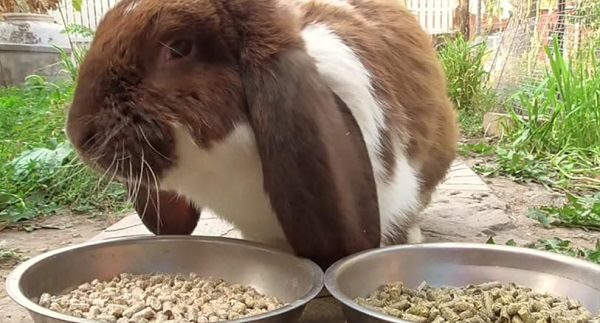
Green feed
Affordable and inexpensive, but at the same time very useful and nutritious food for rabbits. In the wild, it makes up the lion's share of the daily diet for these animals. The use of green plants allows to reduce the concentration in the feed of more expensive components, but still does not allow to abandon them completely.
Succulent green foods are available during the warm season, especially they are easy to get in the middle of spring and early summer before the sun dries them. After a long winter, when rabbits did not receive fresh grass for a long time, it should be introduced into their diet gradually, because a sharp transition affects the intestinal tract, and often leads to the death of a healthy animal.
Of common crops, rabbits can be fed:
- alfalfa;
- sainfoin;
- clover;
- Vika.
In addition to them, not less useful and nutritious are many wild meadow and steppe grasses that are found everywhere:
- plantain;
- burdock;
- dandelion;
- sagebrush;
- nettle, etc.
Roughage
In winter, when there is no fresh grass, the main ration of the rabbit is pre-prepared roughage:
- hay;
- straw;
- tree branches.
Dried grass suitable for hay, which was used in the diet in summer. Dried grass loses its good taste and animals eat it less willingly than fresh. This is true for hay from meadow or steppe grasses. Rabbits search in search of tasty small stalks, throwing out at the same time less interesting. As a result, more than half of the hay is digging under your feet.
More readily and organizedly eaten hay from alfalfa and sainfoin. It is not only tastier than the meadow one, but also homogeneous, thanks to which the animals do not dig, but take stalks in a row.
Since rabbits have long and sharp front teeth that they grow throughout life, they need to be ground. To do this, you need to add young branches of trees to the diet.In summer, the shoots should be without leaves, so as not to cause eating disorders. Rabbits willingly devour the bark while grinding their teeth.
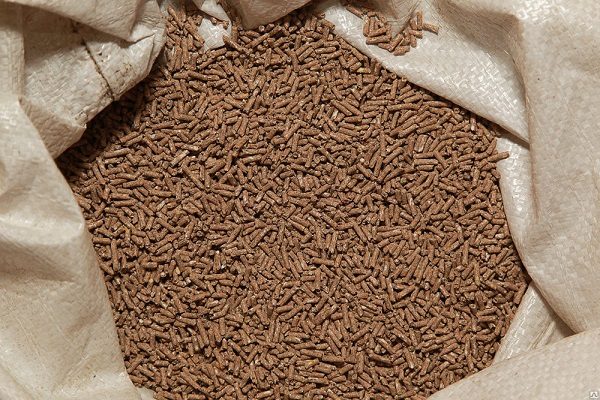
In winter, you can give previously prepared branches, which were cut and dried in late spring or early summer. These branches are harvested together with the leaves, are tied up in small bunches and stored in a dry place until winter, after which little more than 200 grams are added to the ration for each adult per day.
You can use branches in feed:
- oak;
- birch;
- maple;
- alder;
- mountain ash;
- acacias and others
Roots
An important component of the daily diet, especially in winter, when there is an acute shortage of juicy vitamin feed. Rabbits willingly eat roots and tubers, such as:
- beet;
- carrot;
- potatoes;
- Jerusalem artichoke.
Potatoes and Jerusalem artichoke must be pre-cooked, after which they can be served crushed in a mixture with cereal grains and other additives.
Silage
Silo is a beautiful view of feed for winter maintenance of vitamin balance in rabbits. The basis for its preparation is sunflower, corn, carrots, cabbage or beets.It is important to ensure that the silage is not spoiled, so when preparing it, you must strictly adhere to the technology.
To do this, the green mass must be crushed and tightly tamped into the container. Top with a layer of sawdust and sealed with clay. If cracks appear on the clay, they should be immediately smeared to prevent air from entering the silo.
Animals and vitamin-mineral feed
Lack of vitamins and minerals is a very common problem in the winter, especially in the absence of stocks of root crops or silage. In this case, special animals or vitamin-mineral supplements will come to the rescue, such as:
- feed yeast;
- bone flour;
- fish flour;
- a piece of chalk;
- salt;
- tricalcium phosphate, etc.
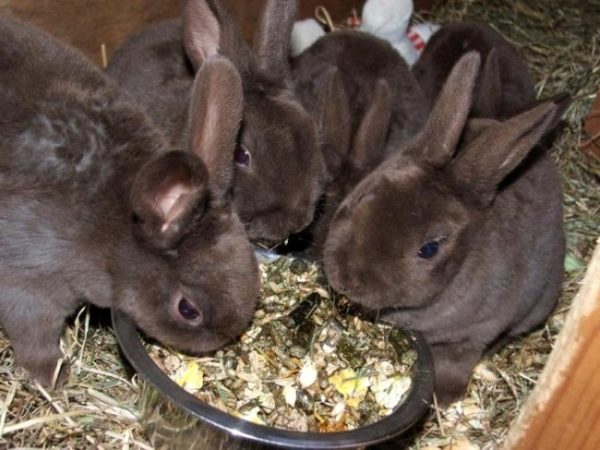
Concentrated feed
This group includes cereal feed. For rabbits, it is best to use a mixture of different types of grain crops, including:
- wheat;
- corn;
- barley;
- oats;
- soybeans, etc.
You can give the grain of one culture in its pure form without mixing, but you should be careful of protein-containing, namely corn and soybeans, which in large quantities can harm.
You may also be interested in the following articles:
Granulated feed
Balanced pelleted feed is able to provide the rabbit with everything needed to grow and maintain the body. This feed consists of a proportional mixture of many components that are pressed into pellets. Such granules are easily eaten by rabbits, while they grind the teeth of animals.
Granules are poured into a special feeder, with which it is eaten by rabbits. This reduces the time spent servicing cages with rabbits, especially when using automatic bunker feeders. In addition, the cell remains clean much longer than when using other types of food, since there is no waste of the uneaten and spoiled food.
For the manufacture of this type of food at home you need special equipment.Therefore, as a rule, dry granules are bought in the store, which incurs significant financial costs. Granulated feed can be selected depending on the age of the rabbit, its sex and breeding goals. This feed is available for:
- little rabbits;
- adults;
- females in lactation;
- fattening for meat.
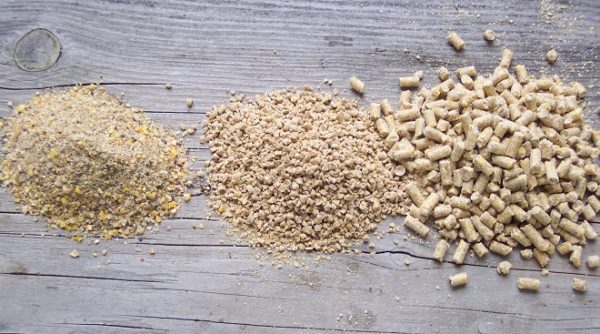
The need for feed
Compound feed is the most useful and nutritious food for rabbits. Its use is especially important when group keeping several animals in one cage. This is due to the fact that a stronger individual will eat the most energetically valuable kind of food, leaving only garbage for weak animals. In the case of feeding feed, this probability disappears, because the whole mass is homogeneous and it is impossible to sort out its components.
Feeding with mixed fodder allows achieving high results of weight gain of rabbits, increasing milkiness in lactating rabbits. This is especially useful in the winter when it is not possible to provide a full-fledged diet using separate types of food.
Cooking feed with their own hands at home
And now let's talk about cooking feed for rabbits at home with your own hands. Independent production of feed reduces the cost of keeping rabbits. For the manufacture of compound feed will need equipment for grinding grain.
There are several popular recipes for feed, with different nutritional indicators depending on the purpose of their application.
Recipe for fattening meat
It is used for feeding animals before slaughter, which allows you to gain the necessary mass in the minimum amount of time. For feeding feed will need:
- grass meal 40%;
- barley 20%;
- corn 10%;
- wheat 10%;
- sunflower oilcake 10%;
- soybean 5.5%;
- fodder yeast 2%;
- meat and bone meal 2.2%;
- table salt 0, 3%.
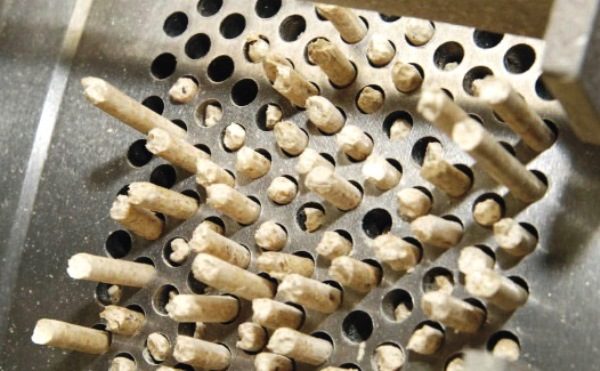
Nutritional Recipe
Used for pregnant and lactating rabbits, male producers with active breeding and squatted calves.It is important not to use compound feed for meat feed for newly laid-off rabbits, since they require a high content of calcium for the initial diet, which is absent in the required amount in other recipes. For enhanced feed must be mixed:
- grass meal 30%;
- barley 20%;
- oats 20%;
- wheat 12.5%;
- sunflower oilcake 13%;
- fish meal 2%;
- bone meal 1%;
- feed yeast 1%;
- table salt 0, 5%.
Seasonal features of feeding rabbits
In the summer, feeding doesn’t cause any trouble, as green fodder is present in sufficient quantities, which, in combination with concentrated ones, are capable of supporting the normal development of the animal’s body. But in winter, roughage that forms the basis of the diet can not provide all the needs, especially for young animals, pregnant women and nursing rabbits.
Thus, feeding the rabbits with compound feed eliminates the need to periodically maintain the necessary level of one or another feed in the cage.It allows you to completely abandon or reduce the consumption of hay, root crops and other components of the daily diet.
In addition, it can be poured into the bunker trough in large quantities, which for a certain period will eliminate the need for periodic feeding. What kind of feed for rabbits is better? Purchased or homemade you decide.
